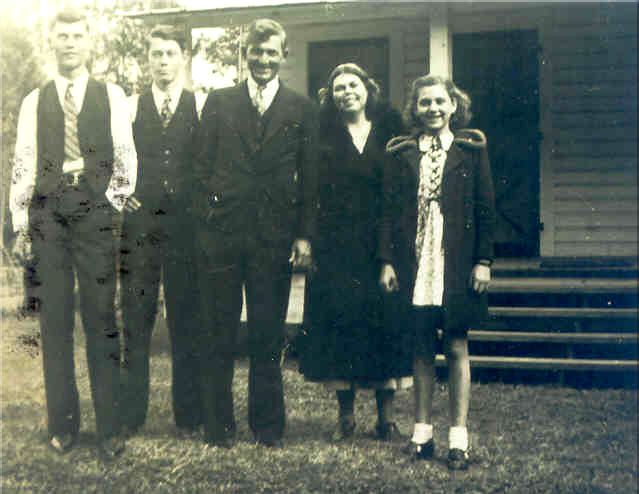
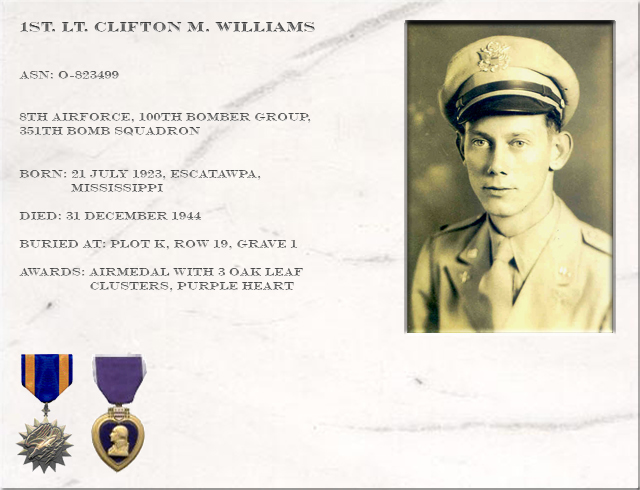
Clifton Williams was born on
July 21, 1923. He lived with his parents Clifton and Irene, his brother, Rudoplh,
and sister Marjorie in Escatawpa, Mississippi.
Clifton studied at the Aviation University of Tennessee in Knoxville.
He had many girlfriends, but was not married.
 |
Picture
of the Williams family. Clifton is second from left. |
When the US came into the
war, Clifton joined the airforce and became a member of the 351st Bomb Squadron,
100th Bomb Group (H). He was trained to become a pilot of a B-17 "Flying
Fortress". He started as a 2nd Lieutenant but eventually promoted to 1st
Lieutenant.
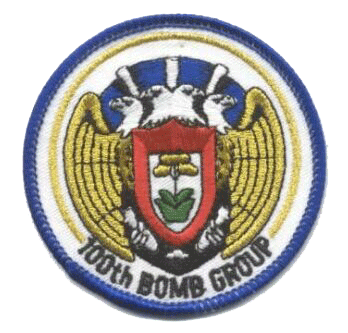 |
The 100th bomb group "Bloody Hundredth" was founded on June 1, 1942 at the Orlando army airbase, Florida. In December 1942 the group excisited out of 39 crews of 10 men per crew. After training in the US the crews flew to England. The groundpersonnel followed later by boat. Their base Thorpe Abbots was about 20 miles south of Norwich and was under command of the 8th airforce. The group now excisted of 4 squadrons the 349, 350, 351 and 418 squadron. The100th bomb group flew it's first combat mission on June 25, 1943 and it's last on April 20, 1945. In these 22 months they flew 306 missions including 6 food-drops over the Netherlands in May 1945. In total they flew 8630 sorties and dropped 19752 tons of bombs and 435 tons of food. The average lifetime of a crew was 11 missions. Between 1943 and 1945 the 100th bomb group lost 229 aircraft, the losses mostly came in large numbers. For example; from a mission to Munster, Germany only 1 of 13 planes returned on Thorpe Abbots. The group participated in the European airwar, Normandy, Northern France, Rhineland, Ardennes and Central Europe campaigns. In December 1945 the 100th bomb group returned to the US where it was de-activated on December 21.
On the 31st of December 1944 the crew flew it's 25th mission, the target was Hamburg, Germany. When they started their bomb run, their plane and the plane above of them was hit by flak. The 2 planes collided in the air, breaking 1Lt. Williams' plane in two at the ball turret. Both airplanes went burning to the ground. 3 crewmembers survived the crash and were taken POW. Clifton died at age 21. 3 other crewmembers are buried beside him at the Margraten cemetery.
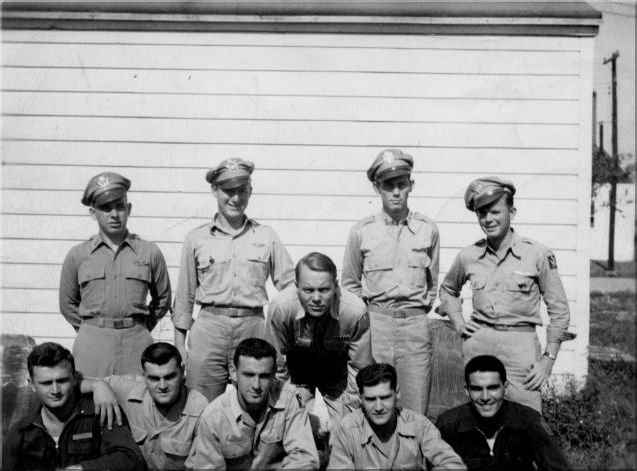 |
|
Picture 1st Lt. Clifton M. Williams and crew
Kneeling:
Alvin H. Petteys, Lee F. Carpenter, Charles J. McGinley, Harvey J. Lehman,
James H. Murphy |
One of the 3 survivors is
2Lt. Lawrence W. Ward, he was taken prisoner and told his story after the war
in 1945:
"While we were on the bomb run the tail gunner called out an enemy jet
high at six o'clock. In answer I checked the crew for oxygen and gave orders
to all the gunners to be especially alert for enemy fighters. All action began
just as the squadron dropped their bombs. I only had time to say "Bombs
Away" when two terrific explosions took place; one under the nose in the
chin turret, the other some where around the center of the ship. The one under
the nose was flak, and pieces of metal seemed to fill the air as they tore thru
the Plexiglas and aluminum. It was at this moment that I received a hit over
the left eye that stunned me. From then on, nothing is clear in my mind as to
what happened.
We immediately went into a spin and I remember trying to climb to the escape
hatch but I didn't have strength to overcome the other forces. The plane straightened
into a dive and as I disentangled myself from all the debris I pulled the red
cord on my flak suit, and started again for the hatch. In that one quick moment
I glimpsed the navigator lying on the catwalk on his elbows looking in my direction.
This covered a fraction of a second and then the nose seemed to disintegrate
and I passed out.
When I came to I was in the open air and just automatically pulled the ripcord
of my parachute. But nothing happened except the red handle came out - I threw
it away and opened the chute by pulling the flaps open. I never remember the
jolt of the chute opening - the next thing I knew was that I was dangling by
one strap It was a habit of mine to hook one side of the harness to the chute
on the bomb run and it never occurred to me to fasten the other side before
opening it. By this time, the bleeding of my wound had stopped - evidently because
the blood over my face had frozen. However, hanging by one strap prevented me
from having any control over myself and I whirled around and around like a top,
making me very sick at my stomach.
I made hasty plans as to evading, but when I landed it was within a fenced-in
estate on the edge of Hamburg. I was immediately surrounded by soldiers and
civilians They took me to the Luftwaffe base where three others from our squadron
were being searched and held. One was my waist gunner and he is the one who
told me the story of our plane. The other explosion I heard was another plane
colliding with us, slicing our plane in half at the ball turret.
When I was a prisoner, the wound over my eye thawed out and began to bleed again
I tried to get it bandaged but to no avail, so I bandaged it with a handkerchief,
and it was over a month before it finally healed."
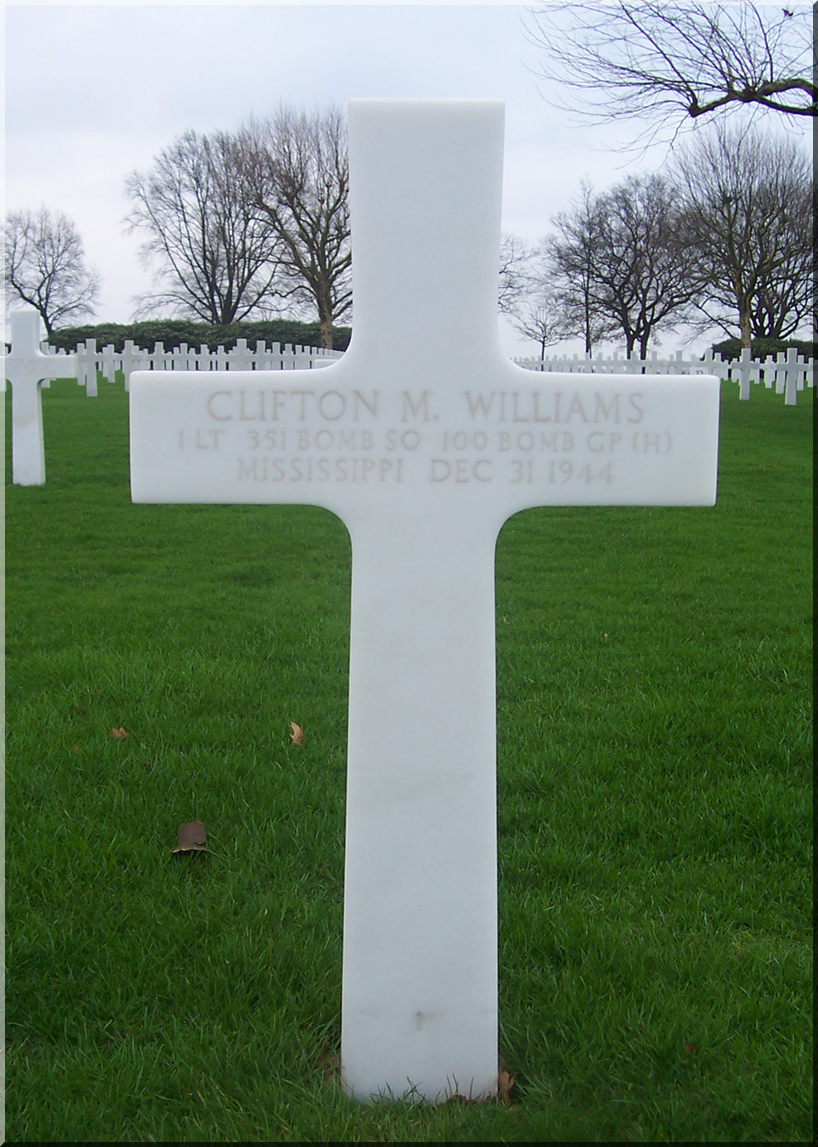 |
Grave
of 1st Lt. Clifton M. Williams |
| A special word of gratitude for sharing information is going out to : Mr. François Dewaide, caretaker of Lt. Clifton M. Williams' gravesite Mr. Robert Duijkers, webmaster of the website Field of Stories, where the story originally was published |